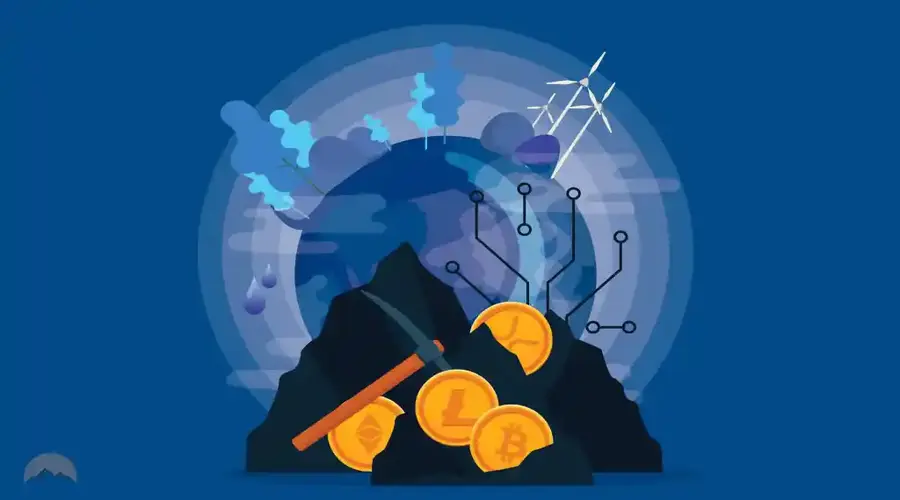
Cryptocurrency mining has revolutionized the financial landscape, offering decentralized and secure transactions. However, the mining process is energy-intensive, leading to concerns about its environmental impact. In this article, we will explore the role of incentive mechanisms in promoting energy efficiency within cryptocurrency mining.
Understanding Cryptocurrency Mining
Cryptocurrency mining is the process by which new coins are created and transactions are verified on the blockchain. Miners use powerful computers to solve complex mathematical problems, adding blocks to the blockchain and securing the network. Cryptocurrency mining is the fundamental process by which new digital currencies are created and transactions are validated and added to the blockchain. It serves as the backbone of decentralized cryptocurrencies, like Bitcoin and Ethereum, ensuring their security and integrity. Miners, individuals or entities, use powerful computers to solve complex mathematical puzzles. Once a puzzle is solved, a new block containing verified transactions is added to the blockchain, and the miner responsible for solving the puzzle is rewarded with newly minted coins and transaction fees. The process of mining requires substantial computational power, and as the network grows, the difficulty of the puzzles increases. This ensures that new blocks are added at a steady rate, maintaining the integrity of the blockchain. Cryptocurrency mining plays a crucial role in maintaining the decentralized nature of these digital currencies, providing a secure and reliable method of recording transactions without the need for a central authority.
The Energy Challenge
The energy consumed in cryptocurrency mining is a contentious issue. The Proof-of-Work (PoW) consensus mechanism, employed by major cryptocurrencies like Bitcoin, demands enormous computational power, resulting in significant energy consumption.
The energy challenge in cryptocurrency mining stems from the energy-intensive nature of the process, particularly in mining operations that utilize the Proof-of-Work (PoW) consensus mechanism. PoW-based cryptocurrencies, like Bitcoin, require miners to compete to solve complex mathematical puzzles, leading to significant energy consumption. As the network grows and more miners join, the computational power required to mine new blocks increases exponentially. Consequently, the energy demands of mining operations rise correspondingly, resulting in higher electricity consumption and associated costs. The energy challenge poses several concerns. First and foremost, the environmental impact cannot be overlooked. High energy consumption leads to a substantial carbon footprint, contributing to climate change and environmental degradation. Critics argue that the energy used in mining could be better allocated to other essential applications.
Additionally, the energy challenge has economic implications. Mining profitability is directly linked to energy costs, and in regions with expensive electricity, mining becomes less financially viable. This could lead to a concentration of mining activities in areas with cheap energy, creating centralization risks and potential security vulnerabilities. Addressing the energy challenge is essential for the long-term sustainability of cryptocurrency mining. Transitioning to energy-efficient consensus mechanisms, such as Proof-of-Stake (PoS), and adopting renewable energy sources are among the potential solutions that the industry is exploring to reduce its energy impact and ensure a more sustainable future.
Incentive Mechanisms for Energy Efficiency
Proof-of-Stake (PoS) vs. Proof-of-Work (PoW)
One approach to enhance energy efficiency is transitioning from PoW to Proof-of-Stake (PoS) consensus mechanisms. PoS allows validators to create blocks and secure the network based on the number of coins they hold. Unlike PoW, it does not require energy-intensive computations.
Difficulty Adjustment Algorithms
Cryptocurrencies can implement difficulty adjustment algorithms to regulate mining complexity based on network activity. Proper adjustments can reduce energy consumption while maintaining network security.
Renewable Energy Integration
Encouraging miners to use renewable energy sources can significantly reduce the carbon footprint of cryptocurrency mining. Incentives and subsidies can be offered to mining operations that rely on clean energy.
Decentralized Governance
Decentralized governance models can foster energy efficiency by enabling miners and stakeholders to make collective decisions on network protocols and energy-related matters.
Impact on Environmental Sustainability
Promoting energy efficiency in cryptocurrency mining contributes to environmental sustainability. By embracing eco-friendly practices, the industry can mitigate its carbon emissions and reduce its overall ecological impact.
The impact of cryptocurrency mining on environmental sustainability has become a subject of increasing concern in recent years. As the popularity and adoption of cryptocurrencies grow, so does the energy consumption associated with mining activities, particularly those employing the Proof-of-Work (PoW) consensus mechanism.
The main environmental concern lies in the carbon emissions resulting from the significant energy consumption of mining operations. The power-hungry nature of PoW mining, with its intensive computational calculations, leads to a substantial carbon footprint. This contributes to greenhouse gas emissions, which are a major driver of climate change.
Another environmental issue is the strain on energy resources. As mining operations scale up, they compete with other energy consumers, leading to increased energy demands. This can lead to higher energy prices and impact the availability of energy for other essential sectors, potentially affecting the overall energy security of a region.
Additionally, the environmental impact extends beyond carbon emissions. Mining operations can lead to excessive heat generation, contributing to localized environmental issues, such as increased ambient temperatures or the need for cooling infrastructure, which, in turn, consumes additional energy.
To mitigate these environmental impacts, the industry is exploring various solutions. Some mining companies are increasingly adopting renewable energy sources, such as solar, wind, or hydropower, to power their operations. Transitioning to more energy-efficient consensus mechanisms, like Proof-of-Stake, is another avenue to reduce energy consumption and carbon emissions.
The cryptocurrency community is becoming more conscious of its environmental responsibility, and ongoing efforts to promote sustainability, develop green mining practices, and explore alternative consensus mechanisms are vital steps towards achieving a more environmentally sustainable cryptocurrency ecosystem.

Technological Innovations for Efficiency
Hardware Optimization
Continual advancements in mining hardware enable greater computational power with reduced energy consumption, making mining operations more efficient.
Liquid Cooling Solutions
Liquid cooling solutions can dissipate heat generated during mining, preventing hardware overheating and optimizing energy use.
Artificial Intelligence and Predictive Analysis
By leveraging artificial intelligence and predictive analysis, miners can optimize their operations, reducing energy wastage and improving profitability.
Energy Recovery Systems
Innovative energy recovery systems can capture and repurpose excess heat generated during mining to power other processes, enhancing overall energy efficiency.
Governmental Regulations and Initiatives
Governments can play a crucial role in promoting energy efficiency within the cryptocurrency mining industry. Implementing regulations, offering incentives for green mining practices, and supporting research and development can foster positive change.
Social Responsibility and Stakeholder Involvement
Cryptocurrency mining companies should embrace social responsibility, engaging with stakeholders and communities to address environmental concerns. Transparency and collaboration can lead to sustainable solutions.
The Future of Energy Efficiency in Cryptocurrency Mining
As the industry evolves, integrating energy-efficient practices will become imperative. Miners, developers, and stakeholders must work together to ensure a sustainable and environmentally conscious future for cryptocurrency mining.
- Transition to Proof-of-Stake (PoS): More cryptocurrencies are expected to shift from the energy-intensive Proof-of-Work (PoW) consensus mechanism to PoS, reducing energy consumption significantly.
- Advancements in Hardware Optimization: Continued innovation in mining hardware will lead to more energy-efficient and specialized mining equipment, maximizing computational power while minimizing energy requirements.
- Sustainable Cooling Solutions: Liquid cooling and other innovative cooling techniques will become more prevalent, effectively dissipating heat generated during mining operations and reducing energy wastage.
- Integration of Artificial Intelligence (AI): AI algorithms and predictive analytics will be integrated into mining operations to optimize energy usage, improving overall efficiency and profitability.
- Renewable Energy Adoption: The mining industry will increasingly rely on renewable energy sources, such as solar and wind power, to power mining operations, reducing carbon emissions and environmental impact.
- Energy Recovery Systems: More sophisticated energy recovery systems will be implemented to capture and repurpose excess heat generated during mining, further improving energy efficiency.
- Green Mining Certifications: Certifications and standards for green mining practices will emerge, encouraging companies to adopt energy-efficient technologies and sustainable mining processes.
- Collaboration for Research and Development: Mining companies, governments, and research institutions will collaborate to develop and share energy-efficient mining technologies, fostering innovation and best practices.
- Public Awareness and Demand: Increasing public awareness and demand for sustainable practices in cryptocurrency mining will push the industry to prioritize energy efficiency and adopt greener solutions.
Conclusion
Incentive mechanisms play a vital role in encouraging energy efficiency in cryptocurrency mining. By transitioning to PoS, adjusting mining difficulty, embracing renewable energy, and promoting decentralized governance, the industry can pave the way towards a greener and more sustainable future.
FAQs
- What is cryptocurrency mining? Cryptocurrency mining is the process of validating transactions and adding blocks to the blockchain using powerful computers.
- How does Proof-of-Stake differ from Proof-of-Work? PoS relies on validators who secure the network based on the number of coins they hold, while PoW requires computational power to mine blocks.
- What are the benefits of renewable energy integration? Integrating renewable energy sources reduces the carbon footprint of mining, making it more environmentally friendly.
- How can artificial intelligence optimize mining operations? AI and predictive analysis help miners optimize energy use, leading to more efficient and profitable mining processes.
- What is the role of governments in promoting energy efficiency? Governments can implement regulations and offer incentives to encourage green mining practices and support research and development.
I have been writing about cryptocurrencies for over two years and I’m widely considered one of the most knowledgeable and respected authors in the space. I have a deep understanding of the underlying technology and market dynamics, and my insights have helped countless investors make informed decisions about their portfolios. I’m a speaker and commentator, and my work has been featured in major publications such as CoinDesk, Forbes, and The Wall Street Journal. I also run a popular cryptocurrency trading signals service that has helped thousands of people make money in the volatile but potentially lucrative world of digital assets.


